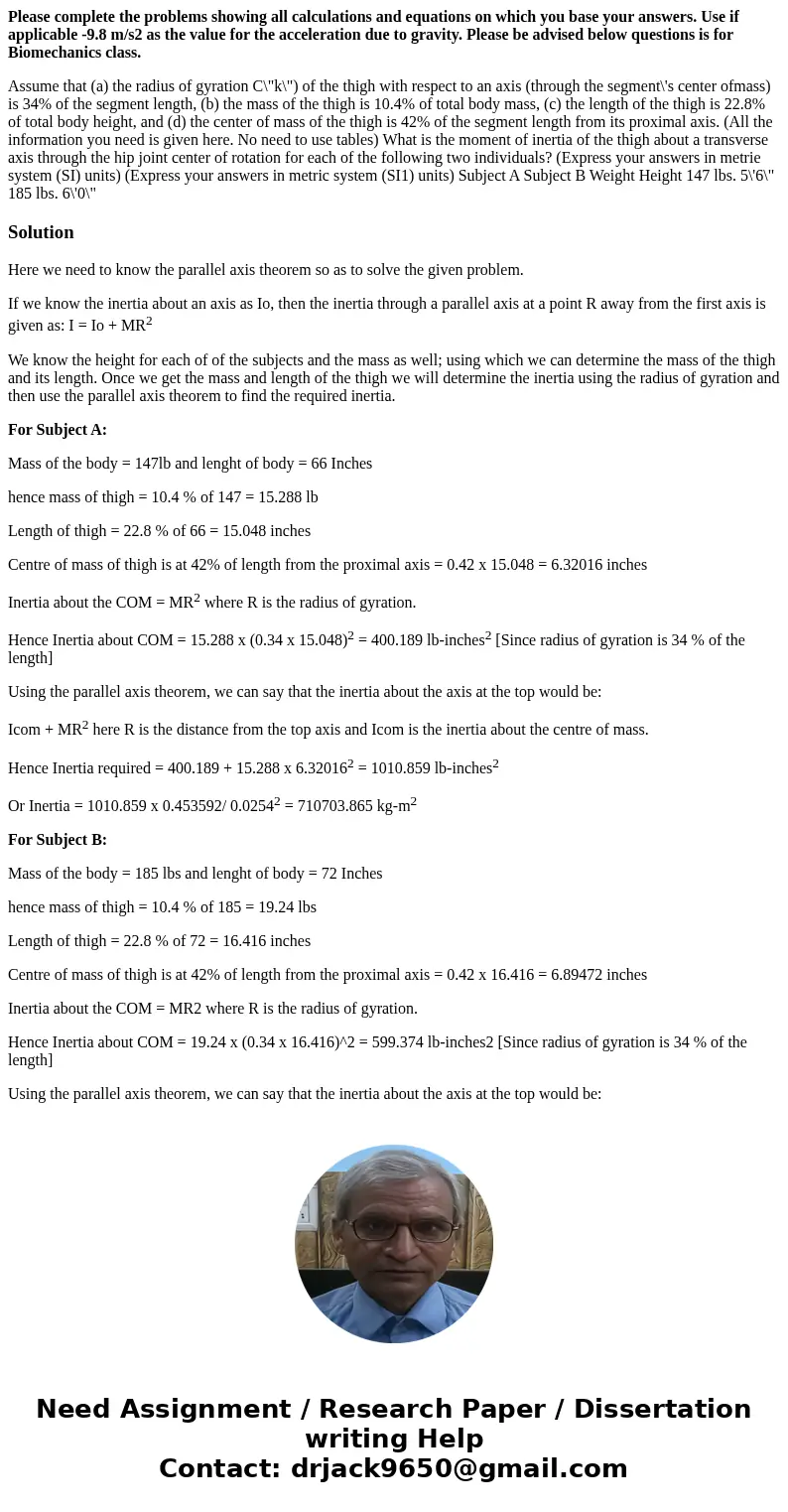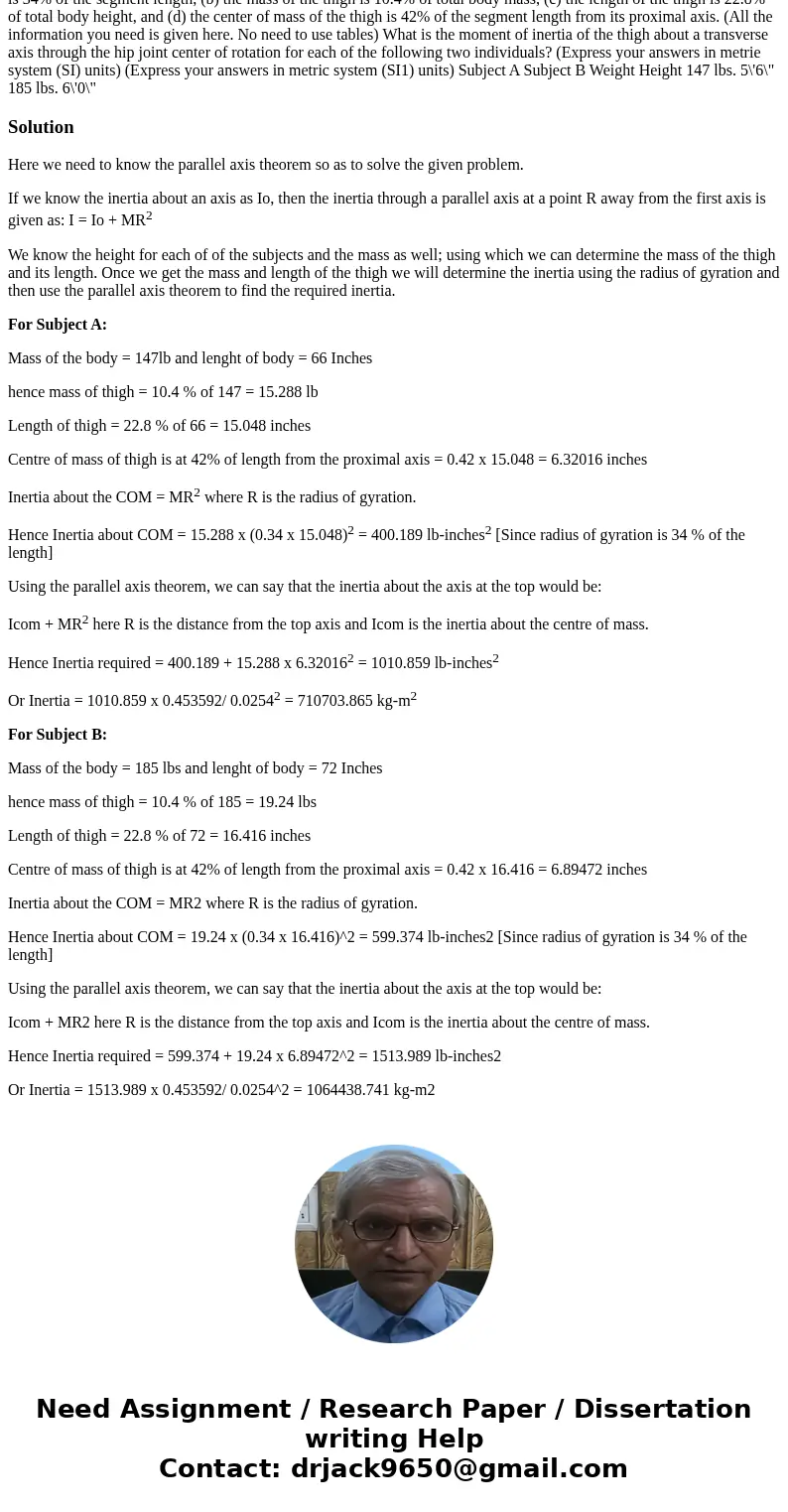Please complete the problems showing all calculations and eq
Please complete the problems showing all calculations and equations on which you base your answers. Use if applicable -9.8 m/s2 as the value for the acceleration due to gravity. Please be advised below questions is for Biomechanics class.
Assume that (a) the radius of gyration C\"k\") of the thigh with respect to an axis (through the segment\'s center ofmass) is 34% of the segment length, (b) the mass of the thigh is 10.4% of total body mass, (c) the length of the thigh is 22.8% of total body height, and (d) the center of mass of the thigh is 42% of the segment length from its proximal axis. (All the information you need is given here. No need to use tables) What is the moment of inertia of the thigh about a transverse axis through the hip joint center of rotation for each of the following two individuals? (Express your answers in metrie system (SI) units) (Express your answers in metric system (SI1) units) Subject A Subject B Weight Height 147 lbs. 5\'6\" 185 lbs. 6\'0\"Solution
Here we need to know the parallel axis theorem so as to solve the given problem.
If we know the inertia about an axis as Io, then the inertia through a parallel axis at a point R away from the first axis is given as: I = Io + MR2
We know the height for each of of the subjects and the mass as well; using which we can determine the mass of the thigh and its length. Once we get the mass and length of the thigh we will determine the inertia using the radius of gyration and then use the parallel axis theorem to find the required inertia.
For Subject A:
Mass of the body = 147lb and lenght of body = 66 Inches
hence mass of thigh = 10.4 % of 147 = 15.288 lb
Length of thigh = 22.8 % of 66 = 15.048 inches
Centre of mass of thigh is at 42% of length from the proximal axis = 0.42 x 15.048 = 6.32016 inches
Inertia about the COM = MR2 where R is the radius of gyration.
Hence Inertia about COM = 15.288 x (0.34 x 15.048)2 = 400.189 lb-inches2 [Since radius of gyration is 34 % of the length]
Using the parallel axis theorem, we can say that the inertia about the axis at the top would be:
Icom + MR2 here R is the distance from the top axis and Icom is the inertia about the centre of mass.
Hence Inertia required = 400.189 + 15.288 x 6.320162 = 1010.859 lb-inches2
Or Inertia = 1010.859 x 0.453592/ 0.02542 = 710703.865 kg-m2
For Subject B:
Mass of the body = 185 lbs and lenght of body = 72 Inches
hence mass of thigh = 10.4 % of 185 = 19.24 lbs
Length of thigh = 22.8 % of 72 = 16.416 inches
Centre of mass of thigh is at 42% of length from the proximal axis = 0.42 x 16.416 = 6.89472 inches
Inertia about the COM = MR2 where R is the radius of gyration.
Hence Inertia about COM = 19.24 x (0.34 x 16.416)^2 = 599.374 lb-inches2 [Since radius of gyration is 34 % of the length]
Using the parallel axis theorem, we can say that the inertia about the axis at the top would be:
Icom + MR2 here R is the distance from the top axis and Icom is the inertia about the centre of mass.
Hence Inertia required = 599.374 + 19.24 x 6.89472^2 = 1513.989 lb-inches2
Or Inertia = 1513.989 x 0.453592/ 0.0254^2 = 1064438.741 kg-m2


 Homework Sourse
Homework Sourse